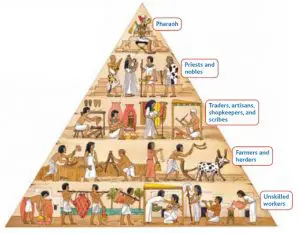The ancient Egyptian community did not follow the idea of socialism. Society was highly polarised and the disparity between the rich and the poor was quite evident. The ruling elite formed the top of the hierarchy and the commoners at the bottom.

In Egyptian paintings, important men are shown as biggest figures and servants as smaller figures. Economic remuneration depended highly on Ancient Egyptian Social Classes status.
Egyptian Social Structure can be Summarised as follows:
Ultimate power was vested in the Pharaoh, the king of Egypt. Though gods were the controllers of the country, Pharaoh was believed to be the god in human form.
Then came government officials such as priests and nobles. Soldiers and scribes came thereafter. This was followed by Merchants, Artisans and farmers. Slaves and servants formed the bottom of the social pyramid.
Pharaohs had absolute power over the subjects. They were entrusted with a lot of responsibilities. They had to control and maintain the army and conduct wars. Law enactment was also at their discretion. The Pharaoh appointed chief priest and other priests. The queens also had special status.
The vizier, who had the status of Prime minister, was appointed by the Pharaoh. He was in charge of tax collection, accounts maintenance etc. He was the closest advisor to the king.
Only nobles could hold government posts; in these positions, they profited from tributes paid to the pharaoh. Priests were responsible for pleasing the gods. Priests were held in high esteem in the religious centred country of Egypt.
Soldiers fought in wars or quelled domestic uprisings. During long periods of peace, soldiers also supervised the peasants, farmers, and slaves who were involved in building such structures as pyramids and palaces. Scribes were that ancient Egyptians who were literate. Most schools were run by scribes and were called scribe schools.
The craftsmen made and sold jewellery, pottery, papyrus products, tools and other articles. They also worked on the decoration of the tombs of kings. Farmers and peasants constituted a majority of the Egyptian population. They tended the fields, raised animals, kept canals and reservoirs in good order, worked in the stone quarries, and built the royal monuments.
Slave system existed though slaves were relatively few in numbers. Legal documents recording the ‘sale’ of individuals are found. Those who were caught as prisoners of war gradually became slaves. Beggars, social misfits, and outlaws were the outcasts of the social system but only little is known of them.
Ancient Egyptian Social Classes mobility was possible. People by using their own talents and skills could move up the social ladder.